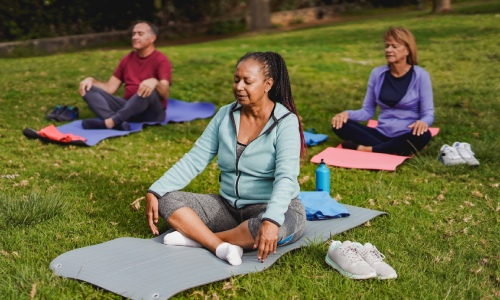How exercise can help lower high blood pressure
- Overview
Becoming more active could reduce your risk of heart disease by 35%, according to the British Heart Foundation.
But how?
- Regular exercise makes the heart stronger: This means it can pump the same amount of blood with less effort, reducing the pressure in the arteries.
- Exercise helps to increase the number of calories you burn: This can help you lose weight (being overweight increases your risk of high blood pressure).
- Physical activity is a great way to destress and spend time with friends: Whereas if you're stressed, it can lead to unhealthy habits that can contribute towards high blood pressure.
What exercise should I be doing?
Adults should aim to do at least 150 minutes of moderate intensity activity per week, or 75 minutes of vigorous intensity activity. Ideally you should do a mix of different intensities across the week.
Doing something is better than nothing, and the 150 minutes can even be broken down into smaller blocks, like 2 x 10-minute bouts of exercise per day.
What is moderate intensity activity?

Moderate intensity activity should noticeably raise your breathing rate above resting and make you feel warm, but you should still be able to hold a short conversation.
Examples include:
- brisk walking
- gardening
- exercise classes
- gentle swimming
- cycling.
What is vigorous intensity activity?
Vigorous intensity activity should make you sweat and make you breathe fast and deep. You shouldn’t be able to speak more than a few words at a time, and you certainly shouldn’t be able to sing.
Examples include:
- swimming laps
- running
- climbing stairs
- heavy gardening (e.g. digging)
- boxing
- circuits sessions.
The type of exercise that counts as vigorous will differ depending on your fitness level and experience – use breathing rate and depth as the best guide.
It's important to note that while the long-term benefits of exercise will help reduce blood pressure, some activities can cause short-term increases in blood pressure and should be avoided if you already have high blood pressure. These include intense weightlifting, sprinting, explosive exercises like burpees and playing squash. If you have high blood pressure, you should talk to a medical professional before starting any of these and opt for less strenuous exercise.
What about strength training?
Yes! All adults should do some form of strengthening exercise each week, although it's less important than cardio for blood pressure management.
Strengthening exercises can help reduce long-term blood pressure by temporarily increasing pressure, especially static exercises that involve squeezing the muscles in place.
It's important to remember explosive or overhead exercises, as well as holding your breath, can increase blood pressure, so these should be avoided if you currently have high blood pressure.
How can I exercise more?

Here are some ideas to get more active:
- Start with short sessions spread throughout the day: This makes it more achievable – even a ten-minute walk counts.
- Exercise with friends or in a group: Exercising with others can help you commit to a session and make it fun. You could go for a walk with a friend, or try a group exercise class.
- Find a friend with similar goals: Getting them to join you in becoming more active is a brilliant way to increase accountability and introduce a friendly level of competition.
- Remember physical activity isn’t just going to the gym: Anything that gets you working harder counts. Try taking the stairs whenever you can, and walking or cycling to get to run errands when possible. Activities like gardening and housework are also great, but be mindful that these won’t always be energetic enough to count towards your total of 150 minutes a week.
References
- BHF (2018). Physical activity and heart and circulatory diseases. British Heart Foundation.
- BHF (2022). Staying active. British Heart Foundation.
- NHS (2021). Physical Activity Guidelines for Adults Aged 19 to 64. nhs.uk.
Last updated Thursday 5 October 2023
First published on Tuesday 28 March 2023

